Tall flowering perennial plants provide vertical visual appeal and bursts of color to any garden. For creating a dramatic landscape backdrop, tall, elegant plants that bloom year after year are ideal. Tall accents in privacy fences are also made up of colorful spring, summer, and autumn blooms on the end of long stems. There is less work involved in keeping your yard lovely since the easy-care plants flower yearly.
Low-maintenance plants include tall perennials that bloom year after year. Mixed beds, borders, edges, and at the rear of flower beds all benefit from the towering flowers. Tall flowering plants may also be used to mask garden eyesores or gorgeous garden scenery along fences.
Rose mallows, coneflowers, oriental lilies, false asters, and hollyhocks are some of the most spectacular tall flowering perennials for their gorgeous pink blooms on the end of long stems. To add color and height to your front or backyard, read on in this article to discover what the best tall flowering perennial flowers are.
What are Tall Flowering Perennials?
Plants that are at least 3 feet (1meter) tall are referred to as tall flowering perennials. These plants bloom yearly and do not need much care. The tall blossoming plants should bloom for many years after being planted in a sunny location in your garden.
Do Perennials Come Back Year After Year?
Year after year, many tall perennials come back. Perennials are plants that bloom the following year after surviving harsh winters. Tall perennial flowers go dormant in the winter and then reappear the following spring. You can have flowers every year with little effort.
It’s important to note that certain types of tall perennial flowers may exhibit indications of aging. Year after year, these long-lived plants produce flowers. They do, however, die off after a few years and must be replanted. While some perennials fade with time, others continue to bloom every year for many years.
Tender perennials
In warm places, tender perennials are plants that survive the winter but are not hardy in cold places. These kinds of flowers bloom as annuals in colder climates since they can’t tolerate freezing temperatures. Therefore, to know if they will return year after year, you must check the plant’s hardiness zone.
Tall Flowering Perennials – Colorful Perennial Flowers (With Pictures)
Now, let’s examine a few of the greatest long blooming perennials that may be utilized in most growing zones. In the coldest growing zones, many of these hardy perennials bloom year after year. Several, on the other hand, are delicate perennials that flourish in warmer regions.
Common Foxglove (Digitalis purpurea)
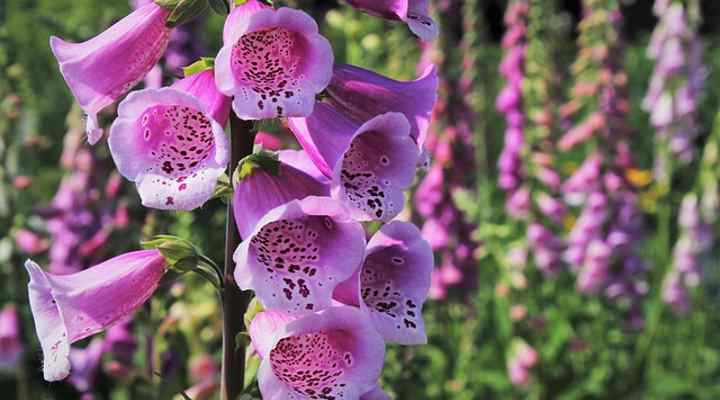
Common foxglove is a tall flowering perennial that grows up to 5 feet (1.5 meters) tall and produces lovely colors in the garden. The end of tall spires is covered in bold, tubular purple blooms. In early to mid-summer, foxglove blooms bloom for a brief period and are up to 3 inches (7 cm) long.
In full sun to partial shade, grow tall foxglove flowers. Flower beds, mixed borders, and vertical interest for shrubs all benefit from foxglove flowers. USDA zones 4 through 8 are ideal for these towering blooming perennials.
Coneflowers (Echinacea)
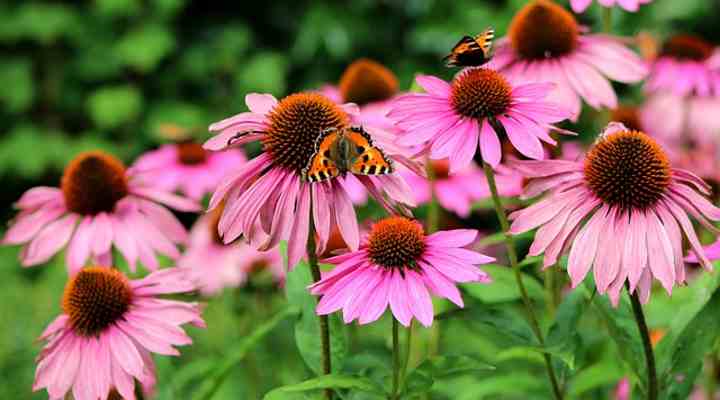
Coneflowers are tall, hardy herbaceous perennials that bloom year after year and need little care. At the tops of 4-foot (1.2 m) stems, gorgeous cone-shaped blooms sit. Coneflowers are drought-tolerant, heat-tolerant, and forgiving plants that are simple to grow.
To add visual impact to beds, borders, and wildflower gardens, grow these tall flowering perennials in masses. On the list of long-blooming perennials that thrive in the sun, coneflowers are included. The big flowerheads’ long purple and pink petals hang limply from the middle of the plant. In zones 3 through 10, these landscape plants thrive.
Black-eyed Susan (Rudbeckia)

Black-eyed Susans are spectacular tall perennials with brilliant yellow blooms that may be planted at the rear of flower beds or borders. These colorful plants, like coneflowers, reach a height of around 4 feet (1.2 meters) in the summer and bloom all summer into the fall. They prefer full sun or partial shade.
To provide vibrant height, plant black-eyed Susans at the rear of flower beds. The long-lasting blooms of Rudbeckia plants are one reason to grow them. As cut flowers or in dried floral displays, the flowering stems last for a long time. Black-eyed Susan is easy to grow in zones 3 through 9 and requires little water.
Rose mallow (Hibiscus)

Several cultivars of rose mallows bloom in a variety of colors and are seen on Hibiscus shrubs. Hibiscus plant cultivars may grow up to 6 feet (1.8 meters) tall and bloom continuously from June through October. These tall plants are adorned with red, crimson, pink, white, and bi-colored trumpet-shaped blooms.
In zones 4–13, rose mallow plants thrives in shrub borders. These perennial flowering bushes may be grown beside streams or ponds and thrive on damp, moisturey soil. The blooms will return year after year once the tall bushy plant has been established. It’s important to check your growing zone before planting perennial hibiscus plants, since some are tender perennials.
Chimney Bellflower (Campanula pyramidalis)
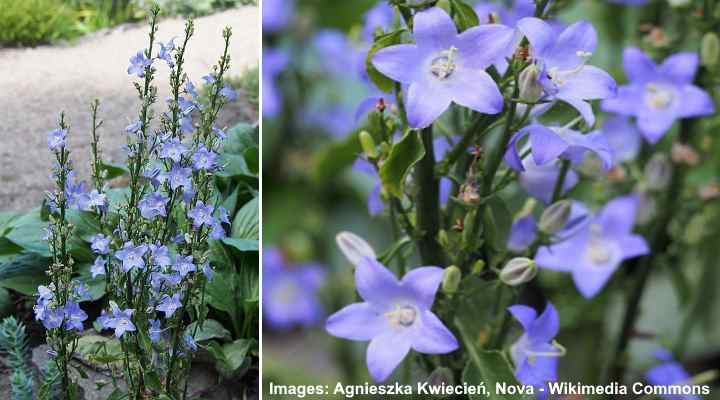
Chimney bellflowers are tall perennials that bloom year after year and offer a vertical accent to the rear of flower beds. Cup, star, tubular, or bell-shaped purple, pink, white, and blue flowers can be found on the tall plants. The clusters of beautiful flowers on campanula plants (bellflowers) grow up to 5 feet (1.5 meters) tall.
Chimney bellflower is a full sun decorative plant that thrives in mixed borders, edging, and at the rear of flower beds. In zones 7 and above, these towering blossoms are hardy and don’t tolerate frost. perennial creeping plants that are suitable for full-sun ground cover, some types of bellflowers
False Aster (Boltonia)

False aster perennial plants produce stunning clusters of daisy-like blooms on long stems, such as the pink beauty (left) and snowbank (right). These towering perennials produce a mound of brilliant white blooms that grows up to 6 feet (1.8 meters) high throughout the summer.
False asters offer easy care and are ideal for planting at the rear of borders. Late-season garden color may be achieved with false asters, which are bushy flowering perennial that bloom yearly after year. These daisy plants thrive in any type of soil and get plenty of sun. In zones 3 – 10, false asters are cold hardy and make a great addition to any garden.
Sneezeweed (Helenium)
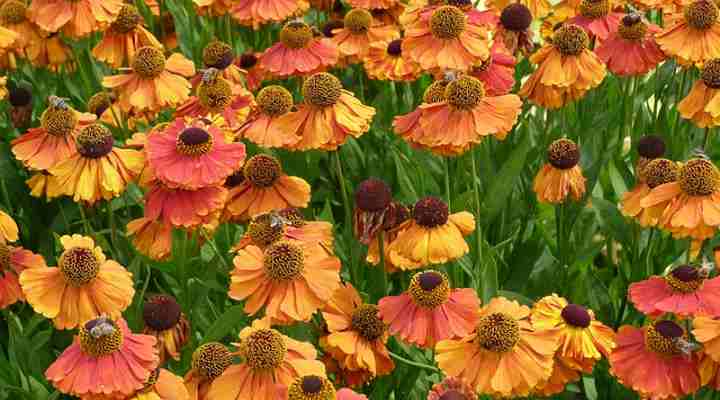
The flowering season of sneezeweed is prolonged by deadheading the flowers of the tall upright sneezeweed. These sun-loving tall plants grow between 3 and 5 feet (1.5 to 1.5 meters) tall, and are also known as false sunflowers or yellow stars. Warm hues of red, orange, and yellow papery blooms adorn the large papery flowers. For the best effect, plant among tall grasses.
During the summer, the tall blooms need to be watered on a regular basis. By deadheading the flowers, you may prolong the blooming season. Cut the tall stems down after blooming so they will come back next year. In zones 3 – 8, sneezeweed is an ideal perennial.
Globe Thistles (Echinops)

Globe thistles bloom with ball-like blossoms that can reach up to 5 feet (1.5 meters) in length. With their straight, tall stems and flowers that are the size of golf balls, easy-care perennials like globe thistles add vertical interest. These flowering perennial flowers thrive in full sun and are ideal for beds and borders.
Among the most distinctive flowers in a perennial garden are globe thistles. They are low-maintenance plants that tolerate cold, heat, and drought. Zones 3 through 9 are ideal for growing.
Hollyhock (Alcea)
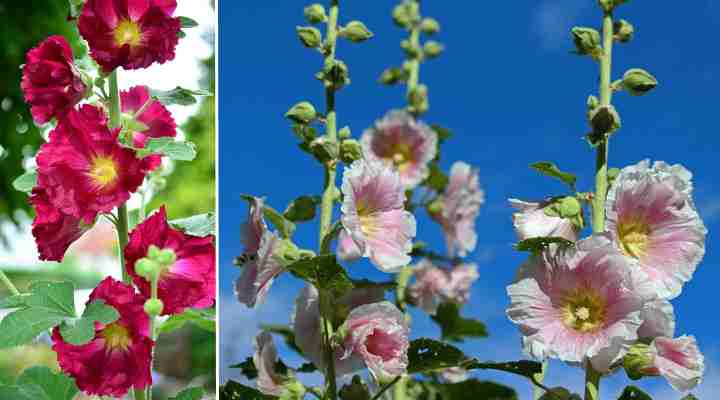
Tall hollyhock plants add a lovely touch to fencing and hedges, and their blooms return year after year. Tall perennial hollyhock varieties with crimson, pink, white, or spectacular burgundy blooms may grow up to 6 feet (1.8 meters) tall. For optimum performance, plant in full sun or partial shade.
Planting along fences, walls, or at the rear of flower beds is ideal for fast-growing plants. The tall spikes with hibiscus-like blossoms produce a profusion of flowers. Cut the blooms back after they have finished flowering in the summer, so they will bloom again the following year. Ideal for cultivating in zones 3 to 8.
Elecampane (Inula helenium)

Elecampane is a sunflower family Asteraceae plant with tall yellow blooms that resemble those of the sun. Thin yellow petals spread out from an orangey core make up the blossoms. The flowers are approximately 6 feet (1.8 meters) tall and resemble sunflowers. In garden landscapes, elecampane flowers create a stunning vertical focal point or border accent.
In full sun or partial shade, grow elecampane flowering perennials. Since the Elecampane plants have established, yearly blooming requires minimal upkeep. Zone 3 – 7 is ideal for elecampane.
Monkshoods (Aconitum)

Monkshoods are tall perennials that bloom in the fall and may grow up to 4 feet (1.2 meters) tall. At the end of long stems, clusters of purple-blue tubular flowers bloom in colorful spikes. Depending on the species, monkshoods have a long flowering period from late summer to late autumn.
Tall plants need full sun and well-drained soil to thrive. Monkshoods are poisonous in all portions of the plants, despite the fact that they provide a blue flower garden. When handling the toxic plant, avoid planting where young children or pets may come into contact with them. Cold hardy to zone 3, these spiky flowering plants.
Red Valerian (Centranthus ruber)

Due to its tall ornamental flowers, red valerian is often grown in gardens. clusters of red blooms fill backyards, borders, and cottage gardens with this prolific bloomer. White, pink, or crimson blooms are available in cultivars of easy-care valerian. Valerian species, which prefer full sun and are drought tolerant, are lovely plants.
Red valerian, with its showy flowers, is one of the longest blooming perennials in the garden, growing up to 3 feet (1 meter) tall. Grow in zones 5 to 8 and enjoy this ideal.
Wild Senna (Senna hebecarpa)

Tall wild senna perennial plants develop to 6 feet (1.8 meters) tall and have a spread of 3 feet (1 meter) in landscaping projects or wildlife gardens. At the end of summer, the flowering plant produces four-week clusters of light-yellow blooms.
As a perennial flowering hedge, wild senna is ideal. Most gardens with low maintenance wild senna are simple to maintain. In sunny gardens, it can grow as a fascinating landscape backdrop. In zones 4–8, this towering perennial thrives.
Meadow Rue (Thalictrum rochebrunianum)

Due to its high graceful and delicate blooms, Meadow Rue adds vertical appeal. In wildflower gardens, as a stunning background plant, or growing together in groups, these bushy flowering clumping plants thrive quickly. Meadow rue is distinguished by its beautiful flowers and foliage, which adds beauty to backyards.
Meadow Rue grows to be 4–6 feet (1.2–1.8 meters) tall with a 3-foot (1-meter) spread. In mid to late summer, the flowers bloom for six weeks. Zones 3 through 8 are ideal for growing plants.
Oriental Lilies (Lilium)

Oriental lilies are lovely tall plants with huge, brilliantly colored blossoms that bloom every year. Annual Oriental hybrid lilies with trumpet-shaped blooms on long, sturdy stalks grow to be 4 feet (1.2 meters) tall. Oriental lilies emerge after the other types of lilies have bloomed.
As garden landscape backdrops, colorful pink, white, red, and multi-colored flowers add visual height. To add color and fragrance to your garden, plant in full sun in zones 4 through 9.
Joe-Pye Weed (Eupatorium maculatum)

Joe-Pye weed produces huge flower heads of dainty pink, purple, red, and lilac blooms that attract butterflies and other pollinators to the garden. To provide a stunning colorful backdrop to garden landscapes, Joe-Pye flowers tower up to 6 feet (1.8 meters) tall.
Easy-care Joe-Pye flowers are excellent accent plants that may be used to create borders or grouped with attractive grasses. In zones 4 through 9, joe-pye weed may bloom in full sun or shadier areas. It’s one of the best flowering perennials for shady places.
Candle Larkspur (Delphinium)

Candle larkspurs are perennials with a diverse range of hues, ranging from tall and elegant delphinium blooms to small yellow blooms. White, blue, purple, pink, or lilac flower spikes support masses of dazzling flowers. The bright, densely packed blooming spikes rise to around 5 to 6 feet (1.5 to 1.8 meters) in height, creating a spectacular background.
Delphinium species are also a great choice for mixed beds and borders. As cut flowers, the long-lasting blooms are also fantastic. In zones 3 to 7, grow perennial larkspurs.
Red Hot Poker (Kniphofia)

Red hot poker flowers have upright flowering spikes that add a architectural touch to landscaped gardens. The blooming spikes are 6 ft. (1.8 m) tall with a flowerhead that is stunning in reds, oranges, and yellows, and the plants are easy to see how they got their common names “red hot pokers” or “torch lilies.”
As vertical accents in gardens, near water borders, or as stunning stand-alone flowering bushes, grow red hot poker flowers. Kniphofias are cold hardy to zone 5 and should be planted after your zone has been checked.
Plume Poppy (Macleaya microcarpa)

Plume poppies are flowering perennials that may be planted in pots for vertical emphasis. The upright stems have clusters of little coral-colored blooms and grow between 6 and 8 feet (1.8 and 2.4 meters). Summer through autumn, the fast-growing, easy-to-grow plants bloom.
To add visual height in your garden landscape, grow plume poppies as a colorful backdrop. In the spring, regular pruning helps to keep its bushy growth. In zones 4 through 9, this tall perennial is ideal.
Canna Lily (Canna indica)

In warmer mountain areas, cannas grow to enormous heights and flourish as tall delicate blooming perennials. Lily-like plants have huge leaves and towering flowering stalks that may grow to be up to 8 feet (2.4 meters) tall, similar to banana plants. Canna lilies thrive best near boundaries, buildings, or bushes when grown in clusters. Variegated foliage with green and bronze leaves is a good option for year-round interest in warm climates.
In colder climates, canna lilies grow as annuals and are not cold hardy. Grow these beautiful plants in containers if you live in zones 7 or lower. Or, before digging up the bulbs and storing them indoors during the winter, plant them in your garden for blooming throughout the summer.
